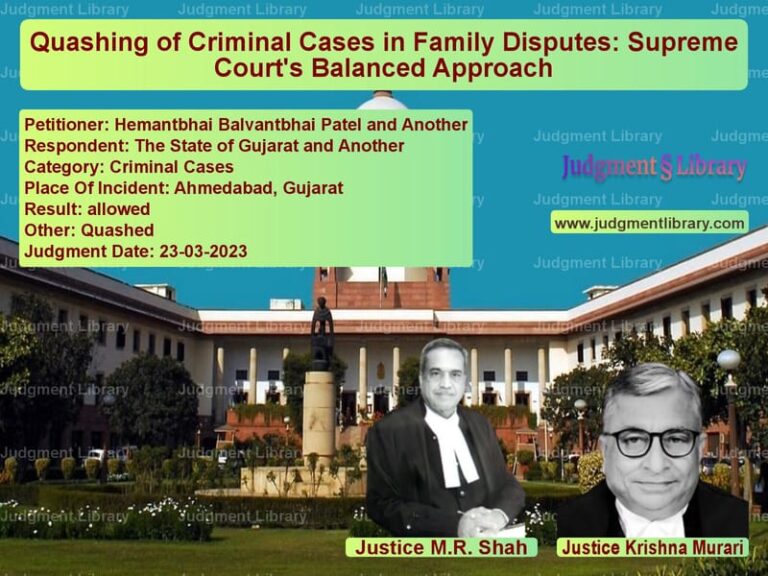Uttarakhand Murder Case: Supreme Court Confirms Conviction and Orders Juvenile Sentencing
The case of Mumtaz @ Muntyaz vs. State of U.P. (Now Uttarakhand) and Dilshad @ Pappu vs. State of U.P. (Now Uttarakhand) is a significant ruling where the Supreme Court upheld the conviction of Mumtaz while referring Dilshad’s case to the Juvenile Justice Board for appropriate sentencing. The case revolved around the brutal murder of Pawan Kumar, who was tied up, doused with kerosene, and set on fire. The prosecution relied on eyewitness testimonies and a dying declaration to secure the conviction.
Background of the Case
The incident took place on the night of December 26, 1990, in the town of Landhaura, Uttar Pradesh (now Uttarakhand). According to the prosecution, the victim, Pawan Kumar, was forcibly taken to the house of a woman named Joulie, where he was tied up and set on fire by the accused.
Pawan Kumar suffered severe burn injuries and succumbed to them the next day while being transported for medical treatment. His dying declaration, recorded at 7:35 AM by a magistrate, became a key piece of evidence in the trial.
Prosecution’s Case
The prosecution presented the following arguments:
- PW-1 Radhey Shyam and PW-2 Anil Kumar, relatives of the victim, were eyewitnesses to the crime.
- The dying declaration of Pawan Kumar explicitly named the accused.
- The forensic evidence confirmed that the victim was burned using kerosene.
- PW-2 suffered burns on his hands while trying to save Pawan Kumar, corroborating the prosecution’s claims.
Defense’s Argument
The defense raised several counterpoints:
- The dying declaration was unreliable because the victim was in extreme pain and may not have been in a clear state of mind.
- The eyewitnesses had personal enmity with the accused and their testimony should not be trusted.
- There was no clear motive for the accused to commit the crime.
Trial Court’s Findings
The Additional Sessions Judge, Roorkee, found the appellants guilty and sentenced them to life imprisonment. However, two other accused, Naseem Khan and Anees Khan, were acquitted due to lack of evidence.
High Court’s Decision
The appellants challenged their conviction before the High Court of Uttarakhand. The High Court affirmed the trial court’s decision, citing the following reasons:
- The dying declaration was clear, detailed, and made before a magistrate.
- The presence of PW-2 at the scene was confirmed by his burn injuries.
- The forensic evidence supported the prosecution’s theory.
Supreme Court’s Observations
The Supreme Court reviewed the case and made the following observations:
- The dying declaration was credible and was made voluntarily.
- The presence of eyewitnesses was corroborated by medical and forensic evidence.
- The High Court was correct in affirming the conviction of Mumtaz.
- Dilshad’s claim of being a juvenile at the time of the crime required further inquiry.
Juvenility Determination for Dilshad
Dilshad’s school records indicated that he was born on July 22, 1974, making him 16 years and five months old at the time of the crime. The District & Sessions Judge, Roorkee, conducted an inquiry and confirmed his juvenile status.
Legal Precedents Considered
The Supreme Court relied on previous rulings on juvenility, including:
- Pratap Singh vs. State of Jharkhand: Defined the applicability of the Juvenile Justice Act to pending cases.
- Bijender Singh vs. State of Haryana: Clarified the sentencing procedure for juveniles convicted under the IPC.
- Jitendra Singh vs. State of U.P.: Directed that juveniles should be referred to the Juvenile Justice Board for sentencing.
Final Judgment
The Supreme Court ruled:
- Mumtaz’s conviction and life sentence were upheld.
- Dilshad’s conviction was confirmed, but he was referred to the Juvenile Justice Board for appropriate sentencing.
- The Juvenile Justice Board was directed to determine an appropriate fine and compensation for the victim’s family.
Impact of the Judgment
This ruling has significant implications:
- It reinforces the credibility of dying declarations in criminal trials.
- It clarifies the application of the Juvenile Justice Act to cases involving accused persons who were minors at the time of the crime.
- It establishes that even convicted juveniles cannot be given standard IPC sentences and must be dealt with under the juvenile justice system.
Conclusion
The Supreme Court’s decision in Mumtaz vs. State of U.P. and Dilshad vs. State of U.P. upholds the principles of justice while ensuring that juveniles are treated in accordance with the law. The ruling underscores the importance of forensic evidence, dying declarations, and fair application of the Juvenile Justice Act.
Don’t miss out on the full details! Download the complete judgment in PDF format below and gain valuable insights instantly!
Download Judgment: Mumtaz @ Muntyaz, Di vs State of U.P. (Now U Supreme Court of India Judgment Dated 01-07-2016-1741873074890.pdf
Direct Downlaod Judgment: Direct downlaod this Judgment
See all petitions in Murder Cases
See all petitions in Juvenile Justice
See all petitions in Judgment by V. Gopala Gowda
See all petitions in Judgment by Uday Umesh Lalit
See all petitions in partially allowed
See all petitions in Remanded to Juvenile Justice Board
See all petitions in supreme court of India judgments July 2016
See all petitions in 2016 judgments
See all posts in Criminal Cases Category
See all allowed petitions in Criminal Cases Category
See all Dismissed petitions in Criminal Cases Category
See all partially allowed petitions in Criminal Cases Category







